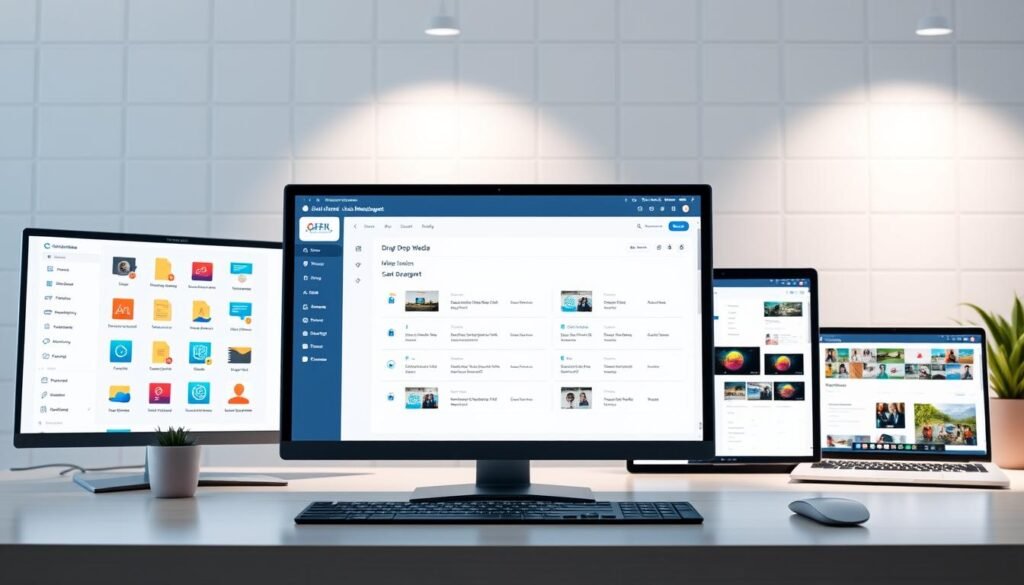In today’s fast-paced online landscape, digital assets have become essential for both businesses and individuals. A recent insight reveals that a significant number of companies are now using online assets to boost growth and revenue.
As noted by a recent insight, “Digital assets are more than just tokens—they’re living, evolving representations of value.” This emphasizes the importance of grasping and mastering virtual assets. It’s vital to stay ahead in the competitive digital world.
Key Takeaways
- Mastering digital assets is essential for online success.
- Online assets drive business growth and revenue.
- Virtual assets are evolving representations of value.
- Understanding digital assets is key to staying competitive.
- Effective management of online assets leads to business success.
What Are Digital Assets and Why They Matter
In today’s digital world, grasping the concept of digital assets is key for businesses looking to excel. Digital assets cover a wide range of content, resources, and property. These are created, managed, and used to meet business goals.
Definition and Scope of Digital Assets
Digital assets include images, videos, documents, and multimedia. The Digital Asset Management (DAM) concept organizes, stores, and retrieves these assets. This supports business operations. The scope of digital assets goes beyond content to include other resources and property essential for success.
The Strategic Value of Digital Assets
Digital assets are more than just files; they are vital for business strategy. They drive decisions, improve customer interaction, and boost revenue. Effective management ensures consistent branding, operational efficiency, and data-driven choices.
How Digital Assets Drive Business Success
Digital assets are key to business success. They enable personalized customer experiences, streamline operations, and foster innovation. They support targeted marketing, enhance customer engagement, and aid in product development. Leveraging digital assets gives businesses a competitive edge and fosters growth.
Types of Digital Assets for Your Business
The digital asset landscape is vast, covering content, financial instruments, and more. For businesses aiming for growth, it’s vital to grasp the various digital assets available. This knowledge is key to leveraging these assets effectively.
Content-Based Digital Assets
Content-based digital assets are at the heart of a company’s online presence. They encompass:
Images, Videos, and Graphics
Visual content like images, videos, and graphics is essential for marketing and brand identity. High-quality visual assets significantly boost a brand’s appeal and engagement. For instance, Content Hub, an Adobe solution, helps companies securely centralize their digital assets. This makes them accessible to different teams.
Documents and Publications
Documents and publications, such as e-books, whitepapers, and blog posts, are critical for establishing thought leadership. They provide value to customers. These electronic assets are used across various channels to attract and engage target audiences.
Financial Digital Assets
Financial digital assets are a growing opportunity for businesses. They include:
Cryptocurrencies and NFTs
Cryptocurrencies and Non-Fungible Tokens (NFTs) are innovative financial instruments for transactions and investments. Understanding their use can open new revenue streams for businesses.
Digital Securities
Digital securities offer a modern alternative to traditional investments. They provide a secure and transparent way to invest in assets. These internet assets are gaining popularity for their flexibility and accessibility.
| Type of Digital Asset | Description | Examples |
|---|---|---|
| Content-Based | Assets used for marketing and brand identity | Images, Videos, Graphics, Documents |
| Financial | Assets used for transactions and investment | Cryptocurrencies, NFTs, Digital Securities |
Brand and Identity Assets
Brand and identity assets are essential for a company’s market presence. They include logos, brand guidelines, and tone of voice documents. Effective management ensures consistency across all channels.
Operational Digital Assets
Operational digital assets are critical for daily business operations. They include software, databases, and digital tools for efficiency. Proper management of these electronic assets is vital for smooth operations.
Building a Strategic Digital Asset Portfolio
In today’s digital world, having a strategic digital asset portfolio is key to business success and staying ahead. A well-thought-out digital asset strategy helps organizations maximize the value of their digital content and online assets.
Conducting a Digital Asset Audit
The first step in creating a strategic digital asset portfolio is a thorough digital asset audit. This process involves cataloging all digital assets, such as content, images, videos, and more. By knowing what assets are available, businesses can spot areas for improvement and growth opportunities.
Experts agree, “To unlock the full value of digital assets, it’s essential to consider their entire lifecycle.” This mindset ensures digital assets are used effectively from start to finish.
“To unlock the full value of digital assets, it’s essential to consider their entire lifecycle.”
Identifying Gaps and Opportunities
After the audit, businesses can pinpoint gaps in their digital asset portfolio and find opportunities for growth. This might mean creating new content, updating old assets, or acquiring new digital properties.
| Digital Asset Type | Current Status | Opportunities |
|---|---|---|
| Content | Outdated | Update and refresh content |
| Images | Limited | Acquire new images or create a image bank |
| Videos | None | Create video content for marketing |
Setting SMART Goals for Your Digital Asset Strategy
To ensure the success of the digital asset portfolio, businesses must set SMART goals. These goals are specific, measurable, achievable, relevant, and time-bound. They guide the development and implementation of the digital asset strategy.
Creating a Digital Asset Roadmap
A digital asset roadmap outlines the steps to achieve the SMART goals set for the digital asset portfolio. It includes timelines, milestones, and resource allocation for successful implementation.
By following these steps, businesses can build a strategic digital asset portfolio that drives success and competitiveness in the digital landscape.
Essential Tools for Managing Digital Assets
Managing digital property and cyber assets demands a strategic approach and the right tools. Today’s digital landscape overwhelms businesses with vast digital resources. These need to be organized, accessed, and utilized efficiently.
Digital Asset Management (DAM) Systems
DAM systems offer a centralized platform for managing digital assets. They enhance collaboration and productivity. They are vital for businesses aiming to streamline their digital workflows.
Enterprise DAM Solutions
Large organizations benefit from enterprise DAM solutions. These offer advanced features like robust metadata management, version control, and integration with other business systems.
Small Business DAM Options
Smaller businesses find value in streamlined DAM solutions. These are cost-effective and easy to implement. They provide the necessary tools to manage digital assets without overwhelming complexity.
Cloud Storage and Collaboration Platforms
Cloud storage solutions allow businesses to store, access, and share digital assets from anywhere. They facilitate collaboration across teams and geographies.
Metadata and Tagging Tools
Metadata and tagging tools are key for making digital assets discoverable and usable. They help organize digital resources by adding context. This makes it easier to search and retrieve assets when needed.

Analytics and Performance Tracking Software
Businesses use analytics and performance tracking software to understand the impact and performance of digital assets. These tools provide insights into how digital assets are consumed. They help gauge their effectiveness in achieving business goals.
By utilizing these essential tools, businesses can improve their ability to manage digital resources. They can enhance collaboration and drive better outcomes from their digital assets.
Best Practices for Digital Asset Organization
Efficiently organizing digital assets is essential for their full utilization and business success. As companies grow, their collections of digital assets—images, videos, documents, and more—expand. This makes maintaining an organized system both challenging and critical.
Developing a Consistent Naming Convention
A consistent naming convention is the cornerstone of a well-organized digital asset library. It simplifies asset identification and retrieval. For instance, combining project names, dates, and descriptive keywords enhances searchability.
- Use descriptive names that indicate the content or purpose of the asset.
- Incorporate dates or version numbers to track updates.
- Avoid using special characters that may cause compatibility issues.
Implementing Version Control Systems
Version control is vital for managing updates and revisions to digital assets. It ensures the latest version is used while keeping a record of past versions.
“Version control is not just about tracking changes; it’s about ensuring that all stakeholders are on the same page.”
Version control can be implemented through:
- Utilizing digital asset management (DAM) systems that offer versioning capabilities.
- Establishing clear guidelines on how to name and store different versions.
- Training staff on the importance and use of version control.
Establishing Access Controls and Permissions
Access controls are essential for safeguarding sensitive digital assets from unauthorized access or modifications. By setting appropriate permissions, businesses can ensure assets are accessed and edited by authorized personnel only.
Key considerations include:
- Defining user roles and their respective permissions.
- Limiting access to sensitive or confidential assets.
- Regularly reviewing and updating permissions as personnel roles change.
Regular Auditing and Cleanup Procedures
Regular audits are necessary to maintain the integrity and relevance of the digital asset library. By periodically reviewing assets, businesses can identify and remove redundant, outdated, or irrelevant assets. This optimizes storage and improves search efficiency.
Creating a Digital Asset Governance Framework
A governance framework provides a structured approach to managing digital assets. It outlines policies, procedures, and standards, ensuring consistency in asset creation, management, and utilization across the organization.
Key elements of a governance framework include:
| Element | Description |
|---|---|
| Policies | Guidelines that dictate how digital assets are managed. |
| Procedures | Step-by-step instructions for implementing policies. |
| Standards | Technical specifications for digital assets to ensure consistency. |
By adopting these best practices, businesses can significantly enhance their digital asset organization. This leads to improved efficiency, reduced costs, and better decision-making.
Optimizing Your Digital Assets for Maximum Impact
Optimizing digital assets can greatly enhance your business’s online presence and engagement. A multi-faceted strategy is essential. It must cover various aspects of digital asset optimization.
SEO Optimization Techniques
SEO techniques are key to optimizing digital assets. They make your content more search engine friendly. This boosts visibility and reach.
Keyword Research and Implementation
Thorough keyword research is vital. It helps identify terms your audience uses. Strategically using these keywords in your content can improve search rankings.
Metadata Optimization
Optimizing metadata, like titles and descriptions, is critical. Accurate and descriptive metadata aids search engines in understanding your content. This enhances discoverability.
Responsive Design for Multi-Platform Assets
In today’s world, responsive design is essential. It ensures your assets work well on all devices. A responsive design adapts to different screen sizes, providing a seamless experience.

Performance Optimization Strategies
Optimizing digital asset performance is key for user engagement. Slow assets can deter users and harm your business.
Compression and File Size Management
Compression techniques can significantly reduce file sizes. This improves loading times. Effective file size management ensures your assets are optimized for the web without losing quality.
Loading Speed Enhancements
Various techniques can enhance loading speeds. Leveraging browser caching and minimizing HTTP requests are effective. Using content delivery networks (CDNs) also helps.
Accessibility Compliance and Inclusive Design
Making your digital assets accessible to all is a legal and best practice requirement. Inclusive design and compliance with accessibility standards can broaden your reach and enhance user experience.
| Optimization Technique | Description | Benefits |
|---|---|---|
| SEO Optimization | Improving search engine rankings through keyword research and metadata optimization | Increased visibility, higher search engine rankings |
| Responsive Design | Ensuring digital assets are accessible across various devices and screen sizes | Improved user experience, broader reach |
| Performance Optimization | Enhancing loading speeds and reducing file sizes | Faster loading times, improved user engagement |
Implementing these strategies can maximize your digital assets’ impact. This leads to better online visibility, user engagement, and business success.
Protecting and Securing Your Digital Assets
The security of electronic assets is a critical concern for businesses aiming to thrive in a digital economy. As companies increasingly rely on digital property, the need to protect these assets from various threats becomes a top priority.
Implementing Robust Backup Systems
A robust backup system is the first line of defense against data loss. This involves regularly backing up your digital assets to a secure, remote location. Cloud storage services are often utilized for this purpose due to their scalability and reliability.
Cybersecurity Measures for Asset Protection
Cybersecurity is a multifaceted approach that includes several key strategies:
- Implementing firewalls to block unauthorized access
- Using antivirus software to detect and remove malware
- Conducting regular security audits to identify vulnerabilities
Encryption and Secure Storage
Encryption is a critical component of cybersecurity, converting sensitive data into a code that only authorized parties can decipher. Secure storage solutions, both physical and digital, further protect your cyber assets from unauthorized access.
Access Control and Authentication
Access control measures, such as multi-factor authentication, ensure that only authorized personnel can access sensitive digital assets. This adds a layer of security against possible breaches.
Legal Protections: Copyright, Trademarks, and Licensing
Beyond technical measures, legal protections play a critical role in safeguarding digital property. Registering copyrights and trademarks, as well as carefully managing licensing agreements, can prevent unauthorized use of your digital assets.
| Legal Protection | Purpose | Benefit |
|---|---|---|
| Copyright | Protects original works | Prevents unauthorized reproduction |
| Trademark | Identifies brand identity | Distinguishes your brand from competitors |
| Licensing | Grants permission for use | Controls how your assets are used by others |
Disaster Recovery Planning
A disaster recovery plan outlines the steps to be taken in the event of a catastrophic loss of digital assets. This plan is essential for business continuity, ensuring that operations can resume quickly after a disaster.
Monetizing Digital Assets for Business Growth
The strategic monetization of virtual assets offers a significant opportunity for companies to boost their financial performance. In today’s digital world, businesses can leverage their online assets in various ways to generate revenue and spur growth.
Direct Revenue Generation Strategies
One of the most direct methods to monetize digital assets is through direct revenue generation. This can be achieved through several models.
Subscription and Membership Models
Implementing subscription or membership models can provide a steady income stream. For example, by providing exclusive content or services to subscribers, businesses can increase customer loyalty and retention.
Pay-Per-Use and Licensing Models
Another effective strategy is to adopt pay-per-use or licensing models. This approach allows businesses to charge for the use of their digital assets, such as software or digital media, on a per-usage basis.
Leveraging Digital Assets for Marketing ROI
Digital assets can also be leveraged to improve marketing return on investment (ROI). By optimizing digital content for search engines and using targeted marketing campaigns, businesses can boost their online visibility and attract more customers.
Content Syndication and Distribution Partnerships
Content syndication and distribution partnerships offer another avenue for monetization. By partnering with other businesses or platforms, companies can expand their reach and generate revenue through syndicated content.
Creating Integrated Digital Asset Ecosystems
Creating an integrated ecosystem of digital assets can further enhance their value. This involves linking different assets together to create a cohesive and complete offer that meets customer needs more effectively.
Measuring Digital Asset ROI
To ensure the effectiveness of digital asset monetization strategies, it’s essential to measure their ROI. This involves tracking key performance indicators (KPIs) such as revenue generated, customer acquisition costs, and customer lifetime value.

By implementing these strategies and continuously monitoring their performance, businesses can maximize the value of their digital assets and drive sustainable growth.
Conclusion: Future-Proofing Your Digital Asset Strategy
The future of digital asset management is here, driven by emerging technologies like AI and blockchain. It’s essential to future-proof your digital asset strategy to stay competitive in the ever-evolving digital landscape.
Embracing AI-driven solutions and blockchain integration will be key for managing and optimizing your digital resources. These technologies offer enhanced security, improved efficiency, and better decision-making capabilities.
To future-proof your digital asset strategy, consider the following key steps:
- Stay updated with the latest technological advancements in digital asset management.
- Invest in AI-driven tools for predictive analytics and automated asset optimization.
- Explore blockchain technology for enhanced security and transparency in your digital transactions.
- Continuously monitor and adjust your strategy to align with changing business needs and market trends.
By adopting these forward-thinking approaches, you can ensure your digital content and cyber assets remain secure, optimized, and aligned with your business goals. The future of digital asset management is exciting and rapidly evolving; being prepared is key to success.
Sources
The following sources were referenced in the creation of this article:
- W3C Accessibility Standards
- Adobe Digital Asset Management
- Optimizely Digital Asset Management
These sources offer critical insights into digital asset management, optimization, and security. They support the strategies and best practices outlined in this article.
FAQ
What are digital assets, and why are they important for businesses?
Digital assets encompass any content, data, or resources in a digital format with value to an organization. They are vital for businesses. They enhance online presence, brand identity, and revenue generation.
What types of digital assets can businesses utilize?
Businesses can use various digital assets. These include content-based assets like blog posts, videos, and e-books. They also include financial assets such as cryptocurrency and digital invoices. Brand assets like logos and trademarks are also important. Operational assets, including software and databases, are essential for day-to-day operations.
How can businesses build a strategic digital asset portfolio?
To build a strategic digital asset portfolio, businesses must first conduct a digital asset audit. They should then identify gaps and opportunities. Next, they should set SMART goals and create a roadmap for acquiring, creating, and managing digital assets.
What tools are essential for managing digital assets?
Managing digital assets requires essential tools. These include Digital Asset Management (DAM) systems and cloud storage platforms like Google Drive or Dropbox. Metadata and tagging tools are also critical. Analytics and performance tracking software are necessary for monitoring and optimizing digital assets.
How can businesses optimize their digital assets for maximum impact?
Businesses can optimize their digital assets through several strategies. Implementing SEO techniques is key. Using responsive design for multi-platform assets is also important. Optimizing performance and ensuring accessibility compliance are critical. Inclusive design should be a priority to reach a broader audience.
What measures can be taken to protect and secure digital assets?
To protect and secure digital assets, businesses must implement robust backup systems and cybersecurity measures. Legal protections such as copyright and trademarks are essential. Disaster recovery planning is also vital for safeguarding digital assets.
How can digital assets be monetized for business growth?
Digital assets can be monetized in several ways. Direct revenue generation strategies are effective. Leveraging assets for marketing ROI is another approach. Content syndication and distribution partnerships can also generate income. Creating integrated digital asset ecosystems and measuring digital asset ROI are key to maximizing revenue.
What is the significance of future-proofing digital asset strategies?
FUTURE-PROOFING digital asset strategies is essential. It allows businesses to stay ahead of emerging trends and technologies. This ensures their digital assets remain relevant and valuable over time.
How often should businesses audit their digital assets?
Businesses should regularly audit their digital assets. This ensures they remain relevant, accurate, and secure. The frequency of audits depends on the size and complexity of the digital asset portfolio.
